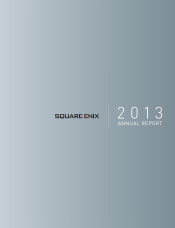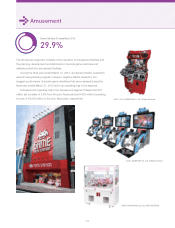Square Enix 2013 Annual Report Download - page 7
Download and view the complete annual report
Please find page 7 of the 2013 Square Enix annual report below. You can navigate through the pages in the report by either clicking on the pages listed below, or by using the keyword search tool below to find specific information within the annual report.
product. Profit opportunities are almost non-existent during the game
development phase. Although we are making on-site efforts to streamline
our game development processes through the use of utility game engines
and other approaches, HD games development requires increasingly
longer time periods as the performance of game consoles improves.
From a financial point of view, investment in game development is being
capitalized on the balance sheet over a significant time frame, and
investment recovery risk increases. In other words, the investment
turnover is low. In consequence, the financial results of the fiscal year
under review were very unsatisfactory, being compounded by the sizable
drop in street prices at the point of sale. I believe the problem is not a
one-time event but a structural issue within the HD games category.
How to address the issue is a major task for the executive team. As noted
above, the HD games category faces the structural issues of an inflexible
earnings model and long-term, large-scale development resulting in a low
rate of investment turnover. These two factors are closely interconnected.
First, we have to create earnings opportunities even before a product is
released in order to raise investment turnover of a long-term, large-scale
development project. Titles of large-scale development are our flagship
The basic business model of the HD games category is to distribute disc
media on which a game is recorded. Many games for consumer game
consoles are still provided on discs, whereas download distribution using
no record media is becoming the mainstream for PC games and additional
content available after a title is released. In the case of the disc-based
distribution model, sales are determined by multiplying the unit price by
the number of discs sold. An increase in shipments or unit price will
naturally drive sales higher. However, supplying games to distribution
channels has become much more difficult in the video game market due
to an increase in the number of titles, in particular, blockbuster titles
competing with each other. As retailers become more selective about
titles to purchase, game publishers have to deal with more expenses
associated with pricing policy, such as back-end rebates, advertising, and
price protection, in order to expand the number of units shipped. As a
result, street prices are substantially declining, which leads to a situation
where profits remain sluggish even though the number of units shipped
increases.
This business model is also having a critical impact on game
development. Under the model of selling packaged games, the timing by
which we may offer a game to customers is limited to the release of the
05




















